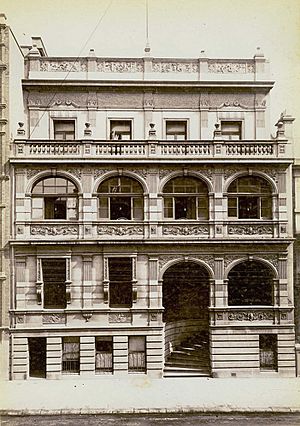German Club, Sydney facts for kids
|
Der Deutsche Verein
|
|

The German Club premises at 89 Phillip Street, Sydney, c. 1900.
|
|
| Formation | 1853 |
|---|---|
| Dissolved | 1915 |
| Location |
|
The German Club (German: Der Deutsche Verein) was a special club for men in Sydney, New South Wales. It started in 1853 and was located on Phillip Street. It was Australia's oldest club specifically for the German-Australian community. The club closed in 1915 during the First World War, due to strong feelings against Germans in Australia at that time.
Contents
History of the German Club
How the Club Started
In the mid-1800s, more and more German people were moving to New South Wales. They wanted a place to meet, relax, and socialize. So, on September 26, 1853, the German Club was created. It was a place where members could read, talk, and sing together.
The club welcomed Germans from all different regions, even before Germany became one united country in 1871. In November 1858, the club, then on Wynyard Square, hosted the crew of the Austro-Hungarian ship, SMS Novara. This ship was on a scientific trip around the world and visited Sydney. The club also helped organize a search for a missing explorer named Ludwig Leichhardt in 1857.
The club moved locations several times. In 1862, it moved from Wynyard Square to O'Connell Street. By the 1880s, it was on Castlereagh Street. In 1890, a fire near the club caused damage, forcing it to move temporarily. A grand new clubhouse was built at 89 Phillip Street, opening in August 1893. It cost a lot of money and had many rooms, including a dining hall, billiard room, and even rooms for members to stay overnight.
Why the Club Closed
When the First World War began in 1914, things became difficult for the German Club. Many members left or were held in special camps. Police searched the club in November 1914 but found nothing wrong. The club even started a fund to help Germans in New South Wales who were struggling.
However, feelings against Germans grew stronger in Australia. In May 1915, the club decided to close on its own. This was because people were worried about damage or violence, especially after a ship called the RMS Lusitania was sunk. Even after closing, the club's building was still a target.
On December 1, 1915, a group of soldiers threw stones at the closed club building, breaking windows. Police quickly stopped them. One soldier was charged and had to pay a fine for the damage. The judge told him his actions were "a disgrace." The club tried to renew its license to reopen later, but the court said no until after the war.
What Happened to the Building
By December 1916, the German Club had fully closed, and its building was put up for sale. In 1917, the Highland Society of New South Wales bought the building. They stayed there until 1932. Later, the building was sold again and changed into offices. The old clubhouse was eventually torn down in 1947 to make way for a road expansion in the city.
Today, some of the traditions of the German Club are carried on by the Concordia Club, which is also known as Deutscher Verein (German Club).
Notable Members
Here are some well-known people who were members of the German Club:
- Ernst Betche (1851–1913) – A person who studied plants.
- C.H.E. Blackmann (1835–1912) – A leading architect in Sydney and a vice president of the club.
- Herman Henry Groth (1832–1903) – A merchant and a mayor of Enfield.
- Wilhelm von der Heyde (1829–1896) – A tobacco merchant, a mayor of Strathfield, and a president of the club. He was also a consul for Spain.
- Adolphus Frederic Feez (1826–1869) – A merchant who built Kirribilli House.
- Carl Ludwig Sahl (1840–1897) – A consul for Germany and a president of the club.

